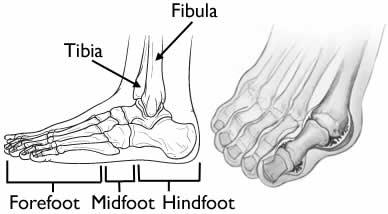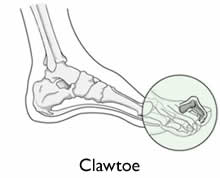Rheumatoid Arthritis in Toes Symptoms
Chronic inflammation of rheumatoid arthritis (RA) can lead to a number of serious complications if poorly controlled. A frequently asked question, which joints are usually affected? The symptoms can vary, but smaller joints are often the first to be affected – for example, joints that attach toes to your feet. The affected joints can be very stiff, painful, and get swelled.
Unlike osteoarthritis (the most common type of arthritis), RA is not associated with injury or repetitive motion. Instead, it is an autoimmune disease that can affect the entire body, including non-joint structures.
 Autoimmune disease is a condition in which the body immune system gets malfunctioned. Normally, your immune system is the core of your body’s defense system. It is important to fight against invaders such as harmful microorganisms and other bad things. But your immune system goes awry with autoimmune disease, attacking wrong targets. It can attack its own healthy tissues, causing a number of serious health problems.
Autoimmune disease is a condition in which the body immune system gets malfunctioned. Normally, your immune system is the core of your body’s defense system. It is important to fight against invaders such as harmful microorganisms and other bad things. But your immune system goes awry with autoimmune disease, attacking wrong targets. It can attack its own healthy tissues, causing a number of serious health problems.
RA occurs when the malfunction of the body immune system mistakenly attacks the lining of the membranes covering your joints called the ‘synovium’, causing inflammation that eventually will also destroy other joint structures such as cartilage, bone, tendons, and ligaments.
What causes this malfunction is unclear. Experts only know that the risk of developing RA increases if you have some of the following risk factors:
- The disease runs in families, though not always. Some experts believe that a genetic component increases the risk. Even when this genetic factor doesn’t actually cause the disease, it makes you more susceptible to other factors (such as viral or bacterial infections) that eventually may trigger RA.
- The disease is more common in the age groups of 40 and 60, though it can affect people of all ages.
- Women are at higher risk than men to develop the disease.
- Lifestyle and environmental factors such as cigarette smoking, exposure to silica /asbestos, and obesity may also have an effect.
Abnormal immune system can cause widespread inflammation, affecting the entire body. Therefore, it’s not uncommon to find some of the following ‘non-joint structure’ complications in people with RA:
- Skin problem.
- Vision impairment.
- Lung disease.
- Cardiovascular disease.
- Blood vessel damage and kidney disease (see more in here).
- Problem affecting bone marrow (anemia).
- And more…
In other words, poorly-controlled RA can be very dangerous or even life-threatening. There is still no any curative therapy. Though it is incurable, prompt treatment can help control and prevent it from worsening.
Some treatments can also drive the disease go into remission (period without symptoms) for years. More years of remission you have, the lower the risk of RA complications to occur and you can still have an average expected lifespan (see more the prognosis in this article).
Though the disease can affect multiple joints throughout the body, pain and swelling in the joints of foot and ankle are more common. In fact, about 20 percent of people with RA find that foot and ankle symptoms are their first signs of the disease. And over the course of the disease, symptoms in the foot and ankle occur in more than 90 percent of all cases.
One of common areas where swelling occurs is forefoot, including toes. See the image below (credit to the Ortho Info of AAOS):

As noted before, RA starts to occur when the body immune system mistakenly attacks synovium.
The changes that occur to the toes affected by RA can vary from patient to patient. These include:
Bunion

A condition of when the joint at the base of your big toe get enlarged, making it crosses over your second toe. Other symptoms include:
- A bony (swollen) bump that forms on the outside edge of the foot.
- Symptoms, such as swelling and pain, get worse with pressure (for example, when wearing shoes).
- Soreness over the affected toes.
- Big toe and second toe can get overlapped, causing callused and hard skin.
- As the problem progresses, the shape of your foot changes, making it not easy to choose shoes that fit.
Claw toe
As the name suggests, having this change means your toes get ‘claw’, digging down (bent over) and you can have painful calluses. The bad news, over time it could be a permanent deformity if left untreated. It can also cause abnormal pressure which then may lead to an ulcer.

What else?
- Bursitis, an inflammation of fluid-filled sac (called bursa) in the joint. Joints of your forefoot (including toes) often perform repetitive motion in your daily activities. Therefore, they are more vulnerable to develop bursitis if you have RA. Bursitis may also develop with bunions.
- Rheumatoid nodule. It can form a lump, could be about the size of a pea. It usually occurs under the skin close the affected joints, especially in area where extra pressure is frequently put on – for example, the big toe joints.
Interestingly, RA tends to affect the joints symmetrically. In other words, it often attacks the same joints on both sides.
For example, if you have a bunion in your left big toe, you will also have the same problem in your right big toe. You might also to read:
Again pain in the foot is common in people with RA. It often occurs before you notice changes to the shape of your toes and foot. The pain usually comes from the inflammation of the joints or ball of the foot.
Treatment for RA in toes varies, depending on the severity of the problem. If the shape of your foot has changed significantly, surgery is often suggested. Surgery can help reset the bones and fuse joints to the normal positions.
Non-surgical treatments are available, but they are only aimed to help relieve symptoms such as pain and discomfort. These include:
- Steroids to help soothe the inflammation.
- Painkillers – as the name suggests, they are used to help relieve pain.
Some lifestyle measures can help, too. Here are some examples:



